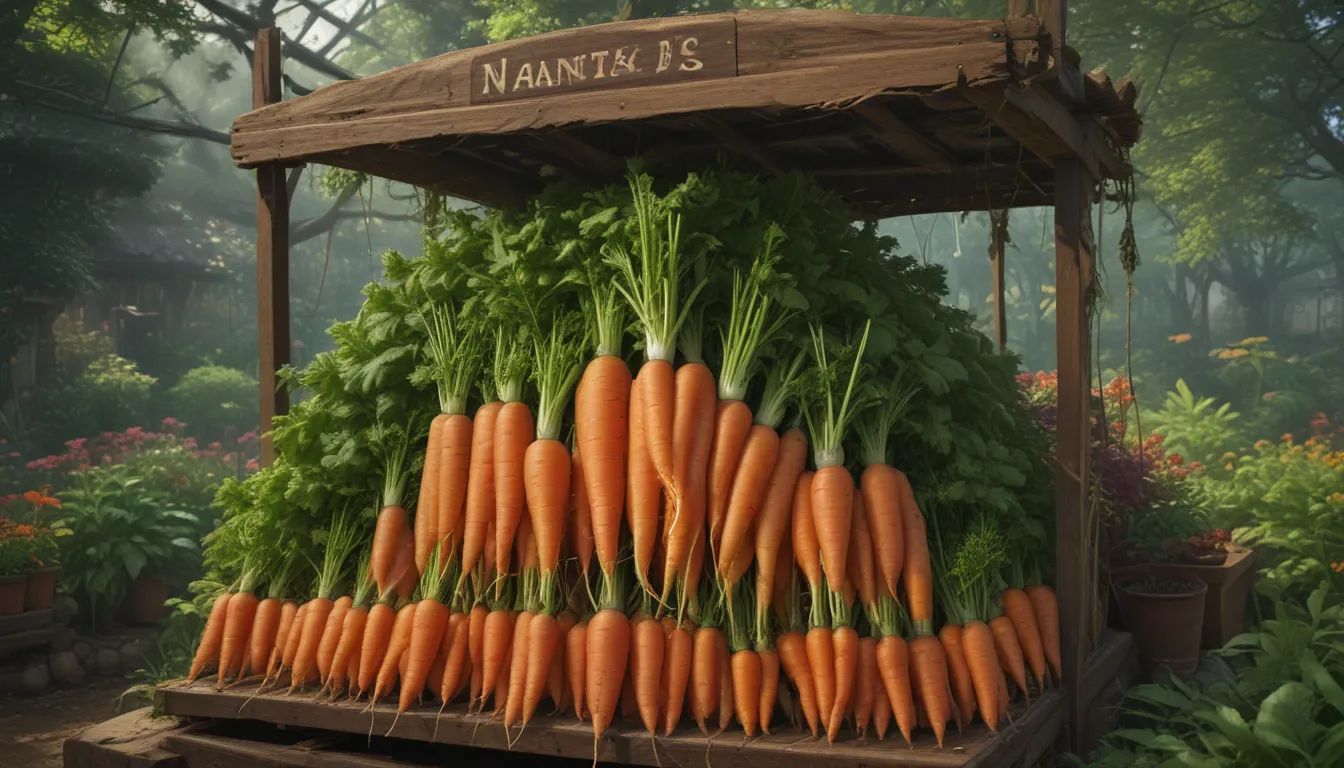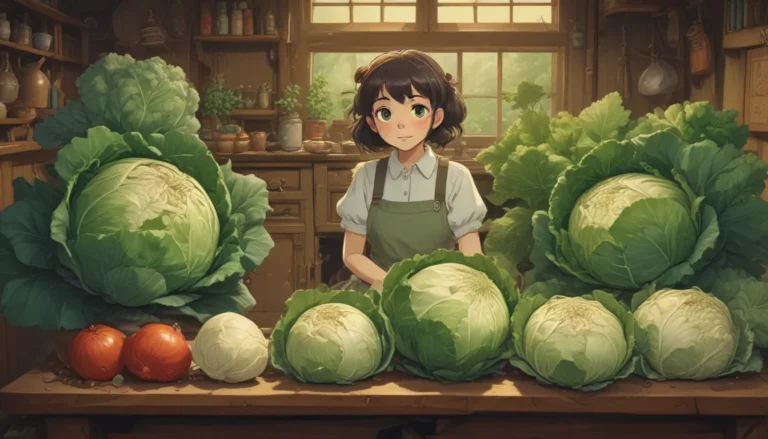Nantes Carrots: A Deliciously Different Addition to Your Garden

Are you looking for a unique addition to your vegetable garden that’s not only delicious but also easy to grow? Look no further than Nantes carrots! These crunchy, flavorful, and fresh root vegetables are a great choice for both novice and experienced gardeners.
In this comprehensive guide, we’ll walk you through everything you need to know to successfully grow Nantes carrots in your own backyard. From planting to harvesting, storage to preservation, we’ve got you covered with all the valuable information you need to grow these tasty veggies.
What Is a Nantes Carrot?
Let’s start by introducing you to the star of the show – Nantes carrots. This variety of Daucus carota, developed by the Vilmorin-Andrieux seed company in the 1850s, is known for its unique characteristics that set it apart from other types.
Nantes carrots are distinguished by their cylindrical, slightly tapered roots, which typically grow to be six to seven inches in length. These roots have a bright orange-red flesh with an almost non-existent core, making them extra sweet and tender. Plus, unlike other varieties, Nantes carrots don’t require peeling, saving you time in the kitchen.
With a relatively short growing time of 65 to 75 days, Nantes carrots are also a great option for gardeners looking to enjoy a quick harvest. Whether you’re a seasoned gardener or a beginner, these flavorful veggies are sure to be a hit in your garden.
How to Sow
Now that you’re familiar with the unique qualities of Nantes carrots, it’s time to get your hands dirty and start planting! Here are some tips on how to sow these delicious root vegetables in your garden:
- Choose a spot that receives at least six hours of sun daily and has sandy or well-draining loamy soil.
- Ensure the soil is deep enough to cultivate to about 10 inches in depth to allow the roots ample space to grow.
- Consider planting in a raised bed if your soil is rocky or heavy, or in a container if space is limited.
- Test your soil for pH and nutritional content to ensure optimal growing conditions for your carrots.
- Plant seeds a couple of weeks before the last frost date in spring and make successive plantings every two to three weeks.
- Keep the soil moist but not soggy until germination occurs, which can take 10 to 21 days.
- Thin seedlings once they reach two inches tall to provide ample space for growth.
By following these sowing tips, you’ll be on your way to growing a bountiful harvest of Nantes carrots in no time!
How to Grow
Once your Nantes carrots have sprouted, it’s essential to provide them with the care and attention they need to thrive. Here are some essential growing tips to help you achieve a successful carrot crop:
- Provide supplemental water as needed to ensure the soil remains moist, especially during warm weather.
- Thin seedlings at two-inch height intervals to allow for proper growth and air circulation.
- Keep the carrot patch free of weeds to prevent competition for water and nutrients.
- Be mindful of pests and diseases that may affect your crop, such as carrot rust flies and Alternaria leaf blight.
- Consider using floating row covers to protect young sprouts from insect pests.
By following these growing tips, you’ll be well on your way to growing healthy and abundant Nantes carrots in your garden.
Varieties to Select
When it comes to selecting the right varieties of Nantes carrots for your garden, there are several options to choose from. Here are a few popular choices that you may want to consider:
- Bolero: An improved hybrid Nantes type with resistance to powdery mildew and fast maturity.
- Nantes Half-Long: Slim and cylindrical in shape, with a slightly blunter end compared to traditional Nantes carrots.
- Nantes Mini Core: Similar to traditional Nantes carrots but with an extra small core.
- Scarlet Nantes: Sweet and deep orange in color, with a length of six to seven inches at maturity.
- Touchon: A Nantes-type heirloom known for its lack of hard fibers and fast maturity.
By selecting the right variety of Nantes carrots for your garden, you can ensure a successful harvest of these flavorful and tender veggies.
Managing Pests and Disease
To protect your Nantes carrots from common pests and diseases, it’s essential to take preventative measures early on. Here are some tips to help you manage pests and diseases in your carrot patch:
- Use floating row covers to protect young sprouts from insect pests like carrot rust flies.
- Consider planting trap carrots to attract wireworms and other pests away from your main crop.
- Rotate your crops annually to prevent the buildup of disease pathogens in the soil.
- Monitor your carrot patch regularly for signs of pests and diseases, such as leaf blight and powdery mildew.
By taking these steps to manage pests and diseases, you can ensure a healthy and productive crop of Nantes carrots in your garden.
Harvesting
When it comes time to harvest your Nantes carrots, timing is key. Here are some tips to help you determine when your carrots are ready to be pulled from the ground:
- Keep an eye on the size of the crowns peeking out of the soil to determine maturity.
- Aim to harvest baby carrots about three weeks before the typical maturity date for the variety you’re growing.
- Use moist soil or light rain to ease the harvesting process and prevent damage to the delicate flesh.
By following these harvesting tips, you can enjoy a bountiful crop of sweet and tender Nantes carrots straight from your garden.
Storage
After harvesting your Nantes carrots, it’s important to store them properly to maintain their freshness and quality. Here are some tips for storing your carrots:
- Remove any dirt from the roots and trim the tops to prevent shriveling.
- Store the carrots in a plastic bag in the crisper drawer of your fridge at 32 to 40°F.
- Wash your carrots thoroughly before eating or cooking them to remove any dirt.
By storing your carrots properly, you can enjoy their fresh and flavorful taste for up to three to four weeks after harvesting.
Preserving
While fresh Nantes carrots are delicious on their own, you may also want to preserve some of your harvest for later use. Here are some tips for preserving your carrots:
- Dehydrate or freeze your carrots for long-term storage.
- Make quick pickles or flavored butter using your carrots for added variety.
By preserving your Nantes carrots, you can enjoy their delicious taste and nutritional benefits all year round.
Recipes and Cooking Ideas
If you’re looking for creative ways to cook and enjoy your Nantes carrots, we’ve got you covered! Here are some recipes and cooking ideas to inspire you:
- Juice, grate, or spiralize your carrots for a fresh and nutritious addition to your dishes.
- Try making herbed lemon carrot salad or herb-roasted carrot tartines for a flavorful and colorful meal.
By experimenting with different recipes and cooking methods, you can discover new and exciting ways to enjoy your Nantes carrots straight from the garden.
Conclusion
In conclusion, Nantes carrots are a delicious and rewarding addition to your garden that are easy to grow and enjoy. By following the tips and information provided in this guide, you can successfully cultivate a bountiful crop of these flavorful and tender root vegetables in your own backyard.
Whether you’re a beginner or experienced gardener, Nantes carrots are a versatile and nutritious choice that can be enjoyed fresh, preserved, or cooked in a variety of ways. With proper care and attention, you can enjoy the sweet taste and vibrant color of Nantes carrots straight from your garden throughout the season.
If you have any questions, comments, or favorite recipes to share, we’d love to hear from you in the comments section below. Happy gardening and happy cooking with your Nantes carrots!
Remember, there are no made-up details. All the information shared is directly derived from the original article provided.





